您当前的位置:检测资讯 > 科研开发
嘉峪检测网 2024-05-06 12:29
摘要
介绍了目前露点温度传感器领域的研究现状,阐述了光学式、谐振式、电学式、热学式、重量式、化学式露点温度传感器的原理及构造,指出光学式露点温度传感器测量精度极高,其中冷镜式露点仪可作为湿度计量标准;谐振式露点温度传感器具有体积小、成本低、响应时间短、灵敏度高、可靠性好的特点;电学式露点温度传感器灵敏度高、功耗小,便于实现小型化、集成化;重量法是准确度最高的湿度绝对测量方法;化学法常用来测量低湿环境下的有机混合气体。探讨了露点温度传感器在环境监测、工业制造、医疗诊断等领域的应用情况,指出未来露点温度传感器将会向高精度、高稳定性、高响应的方向发展,且应用范围将进一步拓展,以满足极端环境下的测量需求。
关键词
湿度测量; 露点温度传感器; 湿度传感器
引言
湿度表示大气中水汽含量的多少,即大气的干、湿程度。可通过绝对湿度、相对湿度、比较湿度、混合比、饱和差、露点温度等对湿度进行表征。露点温度是指空气在水汽含量和气压都不改变的条件下,冷却到饱和时的温度。采用露点温度表征湿度具有以下优势:①可直接将露点温度与环境温度对比,方便控制;②露点温度会随压力的变化而变化,而其他物理量很难对压力变化的气体湿度进行精确描述;③露点温度测量技术较为成熟,准确性较高。目前露点温度测量已被国际公认为最精密的湿度测量方法,世界各国实际的湿度量值传递均通过露点温度实现。
露点温度测量方法可以分为直接法和间接法两种。直接法的原理为:通过主动控温的方式使得界面温度达到气液相态平衡时的温度(即露点温度),利用测温模块对此刻温度进行测量,从而直接获得露点温度。直接法测量精度较高,但是测量成本也较高。间接法的原理为:通过传感器测量与待测气体湿度相关的其他物理量(例如相对湿度、水汽含量等),根据这些物理量推导出露点温度。间接法测量精度相对较低,在测量要求不高的情况下可极大降低测量成本。露点温度传感器对于实现高精度露点检测具有重要意义。根据工作原理的不同,露点温度传感器可分为光学式、谐振式、电学式、热学式、重量式、化学式等。本文详细介绍各类露点温度传感器的结构组成和工作原理,系统总结露点温度传感器领域的发展现状,具体分析露点温度传感器在气象监测、新能源、农业生产、生物医学等领域的应用情况,最后对露点温度传感器未来的发展方向进行展望,为相关领域的科研工作者提供参考。
1、 露点温度传感器工作原理
1.1 光学式露点温度传感器
光学式露点温度传感器利用被测气体中的水分与光的反/散射系数、频率或者相位之间存在的相关性实现露点温度测量。光学式露点温度传感器可分为冷镜式、光谱式、光纤式、图像式等。
1.1.1 冷镜式露点温度传感器
冷镜式露点温度传感器通过制冷元件降低镜面温度,使被测气体中的水分在镜面凝结,镜面反射的光电信号相对参照光电信号发生变化,光电管根据接收信号值判别结露现象,最终实现露点温度测量。冷镜式露点温度传感器结构如图1所示。

图1 冷镜式露点温度传感器结构图
Fig.1 Structural diagram of cold mirror dew point temperature sensor
Brengelmann G L等人[1]提出了基于露点检测的选定皮肤区域汗液率测量方法,该方法误差不超过± 0.8 ℃,灵敏度为± 0.05 ℃,工作范围为-40 ~ 50 ℃,且无滞后。Jachowicz R S等人[2-3]提出了一种通过向露点湿度计镜面注入额外热量稳定温度的新方法,为露点湿度计的设计和运行提供了新的思路。Trampe D B等人[4]提出了一种新的无限稀释活度系数测量技术,该技术涉及极稀气相的构造和露点的精确测定。Ariagno R L等人[5]开发了一种通风胶囊方法,将潜在的测量误差最小化,可对睡眠婴儿的蒸发失水进行逐秒、长期、连续测量,误差在2%以内。Hudoklin D等人[6-7]开发了一种特殊的控制装置来升级仪器的控制回路,且不会对仪器造成电气损害。Brown A S等人[8]详细比较了直接和间接测量烃类露点方法的性能,研究了烃类露点与气体冷凝速率之间的关系,两类方法测量低湿度烃类露点的误差均为± 2 K。Bae Y K等人[9]研究吹扫速率对露点传感器校准、测试及测量不确定度估计的影响,采用标定后的标准冷冻镜式湿度计,分析了不同吹扫时间对露点传感器测量露点温度的影响。
冷镜式露点温度传感器的一般测量范围为-100 ~ 95 ℃,误差不超过± 0.1 ℃,可作为一级计量器具。冷镜式露点温度传感器具有测量精度高的优点,常被用作湿度计量标准,但也存在着设备便携性低、成本高、镜面污染频繁等缺点。
1.1.2 光谱式露点温度传感器
光谱式露点温度传感器通过检测气体对汽化水的能量吸收来测量气体的含水量,其基本单元包括能量源、探测器、隔离特定波长的光学系统、测定光路中水汽引起的辐射能衰减的测量系统等。光谱式露点温度传感器通常使用微波频率至近红外频率的辐射,一般来说,频率越高,波穿透的深度越小。代表性的可调谐二极管激光吸收光谱(Tunable Diode Laser Absorption Spectroscopy, TDLAS)式露点传感器敏感性较高,常用于测量极低含水量环境下的露点。在TDLAS含水量分析仪中,红外激光束穿过吸收室中的待测气体,并被反射镜多次反射以增加路径长度,提高灵敏度。探测器探测光学信号,并将结果传输至数据处理与控制系统中进行处理,结合传感器所测得的温度与压力计算得出露点。TDLAS露点温度传感器结构如图2所示。
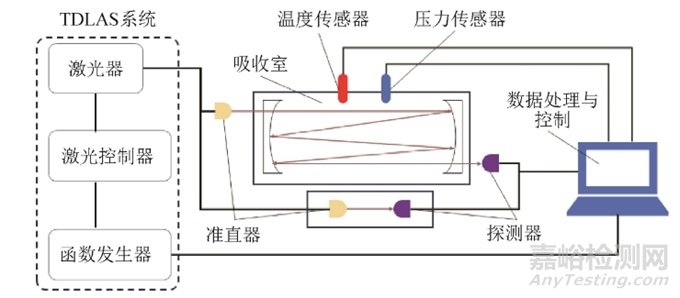
图2 TDLAS露点温度传感器结构图
Fig.2 Structure diagram of TDLAS dew point temperature sensor
Kozlov M G等人[10]介绍了利用真空紫外吸收原理研制的气体湿度光学测量仪,该课题组设计并制造了一台TKA-MK型湿度计,可以测量露点、绝对湿度和相对湿度。Berezin A G等人[11]开发了一种用于测量高纯度氨中微量水分浓度的仪器,这种基于激光二极管的仪器长期灵敏度估计为5 × 10-14。Cerni T A[12]研制了一种现场耐用型红外差分吸收湿度计并进行了测试。在-15 ~ 10℃的露点/霜点范围内,露点/霜点测量误差不超过± 0.5℃。Koglbauer G等人[13]提出了一种利用傅里叶变换红外光谱测量压缩湿氮、氩气和二氧化碳露点的新方法,该方法具有较高的可靠性。Underwood R等人[14]报导了一种能够在空气中同时非接触测量温度和湿度的装置,并在气候室中进行了测试。该装置使用了声学温度计和可调谐二极管激光吸收光谱仪,不需要固体基质中的水分与周围空气平衡即可进行测量,对湿度变化响应极快,使用温度范围为-40 ~ 40 ℃,露点范围为-43 ~ 38 ℃,测量误差不超过± 1 ℃。聂伟等人[15-16]提出了利用TDLAS技术实时在线测量露点/霜点温度的传感器,并通过初步实验证明了该传感器的可行性和技术优势,其露点/霜点温度为-93 ~ 14.5 ℃,测量不确定度小于2%,响应时间约为0.8 s,相较冷冻镜式湿度计响应更快;该传感器的测量结果与高精度冷冻镜湿度计测量结果的最大偏差小于0.9 ℃。Khelifa N[17]提出使用分布式反馈(Distributed Feedback Laser, DFB)激光二极管的光学系统,讨论了利用光谱学检测水汽的可能性,并观察冷镜式露点传感器测量露点温度时产生的吸收线形状和位置的变化。Li等人[18]基于TDLAS技术,设计并搭建了嵌入式含水量测试仪、低温露点发生器、MBW湿度标准装置、变温冷冻机等设备,验证了传感器在环境温度升高时的水蒸气释放效果和环境温度降低时的水蒸气吸附效果,并定量测量了不同温度变化、不同水蒸气浓度、不同流量下的水蒸气释放程度和吸附效果。Nowak J L等人[19]提出一种快速红外湿度计(Fast Infrared Hygrometer, FIRH),确定了3个显著影响测量的因素(即吸收线的自增宽、玻璃窗的干扰和风洞外环境空气的寄生吸收),并开发了针对这些影响的修正方法。与参考湿度计(露点仪MBW 973)的比较实验表明:在露点温度为-5.4 ~ 21 ℃,环境温度为23 ℃的条件下,FIRH具有良好的准确性。
光谱式露点温度传感器的一般测量范围为-90 ~ 20℃,误差不超过± 0.5 ℃,通常用于工业级微水分的测量。虽然光谱式露点温度传感器适用于极低水气含量的测量且具有很高的测量精度,但其中的分析仪价格昂贵,且露点传感器需要不断维护,同时光谱式露点温度传感器对光源器件性能依赖较大。
1.1.3 光纤式露点温度传感器
光纤式露点温度传感器通过测量折射率与被测气体湿度的关系实现露点检测。激光器发射的激光通过光纤,之后经过测量管路并被光电检测器检测,检测结果传输至示波器并被系统采集,当测量管路中的露点温度发生变化时,传感光纤中的折射率也会发生变化,根据折射率的变化推导出露点温度。光纤式露点温度传感器结构如图3所示。
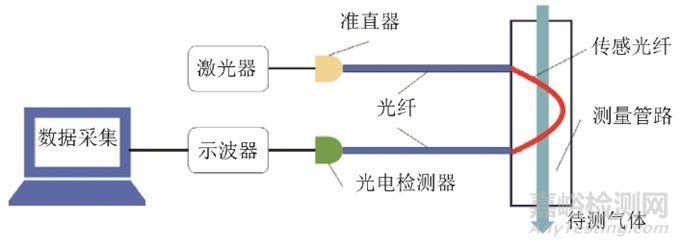
图3 光纤式露点温度传感器结构图
Fig.3 Structural diagram of fiber optic dew point temperature sensor
Matsumoto S[20-21]设计了一种基于激光二极管和光纤电缆的新型光露点传感器。利用带积分器的比例控制电路,控制表面粗糙、随时间低水平振荡的金板上的结露量,实现传感器的测量,在10 ~ 50 ℃的大气环境中,测量露点为-3 ~ 40 ℃,误差不超过± 0.5 ℃(± 2% RH),测量时间间隔为6 ~ 31 s。Mathew J等人[22]设计了一种基于反射模式光子晶体光纤干涉仪的露珠检测传感器,该传感器测头制造工艺简单,仅涉及切割和融合拼接。该传感器测量露珠形成的灵敏度较高,在露珠开始形成时干涉图的波长峰偏移较大。Kostritskii S M等人[23]研制并试验了基于光纤切割反射系数变化的光纤式露点传感器,提出并验证了传感器中凝结探测模块的工作原理模型,并对不同露点的空气进行测量,结果表明该传感器在-32 ~ 0 ℃的露点范围内具有较高测量精度。Chen G Y等人[24]展示了一种具有极短响应时间的微型快速响应湿度计,测量响应时间为3 ms,恢复时间为36 ms,灵敏度高达0.4% RH,检出限低至1.6% RH。在达到可恢复露点之前,最大相对湿度为99% RH。Limodehi H E等人[25]介绍了一种基于表面等离子体共振(Surface Plasmon Resonance, SPR)与水汽凝结关系的多通道光纤露湿传感器,该传感器能够通过不同位置的光纤通道即时检测水分或露水,并可同时测量多种环境的相对湿度和露点温度,误差不超过± 5%。
光纤式露点温度传感器的一般测量范围为-10 ~ 40 ℃,误差不超过± 0.5 ℃,通常用于测量低温风洞等工业领域的露点温度。光纤式露点温度传感器具有抗干扰能力强、体积小等优势,但成本较高,且测量效果受光源与检测器的性能影响。
1.1.4 图像式露点温度传感器
图像式露点温度传感器通过摄像机跟踪拍摄镜面,并实时采集镜面的图像数据,提取镜面的状态特征来判断镜面是否结露或霜,结构如图4所示。
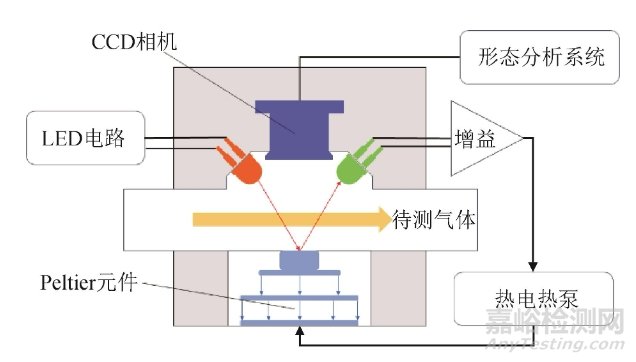
图4 图像式露点温度传感器结构图
Fig.4 Structural diagram of image based dew point temperature sensor
Weremczuk J等人[26]提出了基于露点湿度计探测器(半导体镜像)图像形态学分析的过冷水识别方法,该方法置信率高(约96%),具有通用性,可应用于铜镜或半导体镜湿度计,能够自动校正测量误差。Ishida K等人[27]利用Peng⁃Robinson状态方程建立了以固相为凝聚相的相平衡体系的露点和霜点估算方法,设计并制作了采用原始可见图像分析的冷镜技术的高压试验池露点和霜点测量系统,该系统适用于测量霜点温度低于-50 ℃下的环境湿度。
图像式露点温度传感器的一般测量范围为-60 ~ 20 ℃,误差不超过± 0.4 ℃,早期用于替代冷镜露点仪。图像式露点温度传感器的优势在于能够实现对露、过冷水和霜的识别,但测量精度较低,通常用于定性研究。
光学式露点温度传感器指标如表1所示。
表1 光学式露点温度传感器指标单位:℃
Tab.1 Index of optical dew point temperature sensor
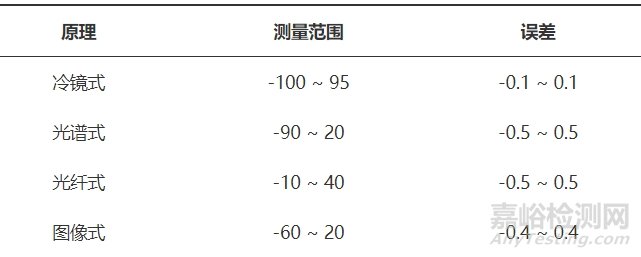
1.2 谐振式露点温度传感器
谐振式露点温度传感器利用器件表面结露时产生的频率变化实现露点测量。谐振式露点温度传感器可分为石英晶体式(Quartz Crystal Microbalance, QCM)、声表面波式(Surface Acoustic Wave, SAW)、压电微机电系统(Micro⁃Electro⁃Mechanical System, MEMS)式、谐振腔式、光子谐振式等。
1.2.1 QCM露点温度传感器
QCM露点温度传感器结构如图5所示,测量时,对石英晶片进行制冷,使其表面结露,石英晶片电极表面质量发生改变,利用石英晶体的质量⁃频率效应进行露点识别,从而推导出露点温度。

图5 QCM露点温度传感器结构图
Fig.5 Structural diagram of QCM dew point temperature sensor
1999年,Shapiro A P等人[28]报导了一种基于石英晶体振荡器的非光学烃类露点测量传感器,可用于测量天然气的露点,误差不超过± 1 ℃。连续读数之间的周期时间通常小于10 min。Joung O J等人[29]提出了一种基于石英晶体传感器的有机蒸汽混合物露点测量装置,在丙酮⁃甲醇混合物中对其性能进行了测试,并将测试结果与UNIQUAC方程的预测露点以及其他实验的结果进行了比较,平均误差不超过± 0.27 ℃,平均最大误差不超过± 1.6 ℃。Kwon S Y等人[30-31]开发了一种QCM露点 / 霜点传感器,提供了一种简单而准确的区分露点、过冷露水和低于0 ℃霜的方法,将石英谐振器的谐振频率作为温度的函数,一次扫描即可区分过冷露水和霜。该传感器工作温度范围非常宽(-90 ~ 15 ℃),在整个范围内误差不超过± 0.1 ℃。聂晶等人[32-54]提出了基于敏感电路的露点测量方法,在Colpitts电路中使用石英晶体作为湿敏元件,由于Colpitts电路在液体环境下不能驱动石英晶体振荡,使用Peltier元件对石英晶体进行冷却,直到石英晶体在液相环境下产生露珠。当发生冷凝时,Colpitts电路振荡停止,获取振荡停止时石英晶体表面温度,从而识别并测量露点。该方法可以在露点温度-30 ~ 50 ℃,相对湿度1 ~ 90% RH的范围内实现测量,露点温度测量误差不超过± 0.3 ℃,相对湿度测量误差不超过± 1%。同时,该团队还研制了一种基于双石英晶体谐振器(Double⁃Quartz Crystal Resonator, D⁃QCR)的露点传感器,该传感器将Peltier模块与2个QCR相结合,其中一个QCR仅提供无气体接触条件下的参考频率,另一个QCR用于测量有气体接触条件下的露点。与MICHELL S4000露点仪的对比实验表明,该传感器最大测量误差不超过± 0.47 ℃。此外,该团队采用蒙脱土(Montmorillonite, MTT)或二硫化钼(Molybdenum disulfide, MoS2)涂层的QCM露点传感器与露点识别算法相结合的方法进行露点检测。采用该识别算法对3种QCM传感器输出的频率信号进行处理,并与MICHELL S4000提供的标准露点数据进行比较,结果表明,在3 ~ 15 ℃环境下,采用MTT涂层的QCM传感器具有最佳的测量精度和重复性,与标准露点值对比,最大相对误差不超过± 0.3 ℃。Esmaeilzadeh H等人[55]利用UV胶或热固化胶将可更换的PMMA平板和柱状膜附着在QCM基板上,开发了一种新型声波谐振器装置,该装置具有较高检测灵敏度。
QCM露点温度传感器的一般测量范围为-90 ~ 15 ℃,测量误差不超过± 0.1 ℃,通常用于测量微水分环境的露点温度。QCM露点温度传感器的优点是考虑了温频影响,测量精度高,但未考虑粘滞效应带来的频移,影响因素无法量化。
1.2.2 SAW露点温度传感器
SAW露点温度传感器的结构如图6所示,通过叉指换能器(Interdigital Transducer, IDT)将电磁波转化为声表面波,当待测气体中的水分在石英表面凝结后,介电常数和密度等发生变化,声表面波发生衰减,根据声表面波传感器谐振频率的变化推导出露点温度。
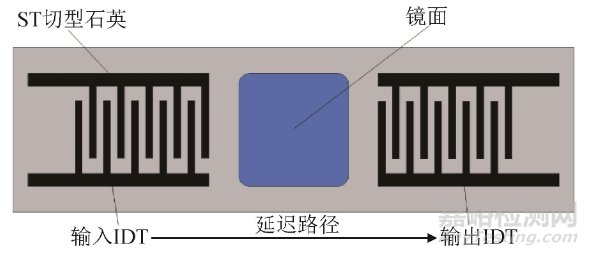
图6 SAW露点温度传感器结构图
Fig.6 Structural diagram of SAW dew point temperature sensor
Vetelino K等人[56-59]提出了一种新型的SAW / 光学混合传感器,相较传统光学式传感器,该传感器不易受到表面污染的影响,且最小可检测表面密度小两个数量级,该SAW振荡器露点系统的测量分辨力为0.3 ℃,而商用光学露点传感器的分辨力为0.2 ℃。Hoummady M等人[60]研究了露水沉积对Rayleigh波特性的影响,采用Peltier元件对SAW芯片冷却,直至结露。由于Rayleigh波的极化,露水沉积引起了波振幅的大幅衰减和波速的偏移。初步实验结果证实了SAW对露水沉积的敏感性。Hansford G M等人[61]设计了一种气球运载的大气水汽剖面露点/霜点湿度计,该仪器以SAW传感器为基础,具有较为轻便的优点,在极低湿环境中的测量性能较好。Takeda N等人[62]利用SAW传感器的2种频率,在痕量水分分析仪中分离并补偿背景气体成分对痕量水分测量的影响。
SAW露点温度传感器的一般测量范围为-60 ~ 20 ℃,测量误差不超过± 0.3 ℃,通常用于测量生物等领域的露点温度,具有体积小、成本低、灵敏度高、功耗低等优势,但是抗干扰能力较差。
1.2.3 压电MEMS露点温度传感器
压电MEMS露点温度传感器的工作原理:冷却器降低温度,压电MEMS露点温度传感器的谐振频率随着温度降低而增加,这种趋势一直持续到温度达到露点温度,在露点温度下,谐振器表面形成一层薄霜/露水层,共振频率开始下降,谐振器频率在薄霜/露水层形成之前达到最高水平,根据谐振器频率推导出露点温度。压电MEMS露点温度传感器结构如图7所示。
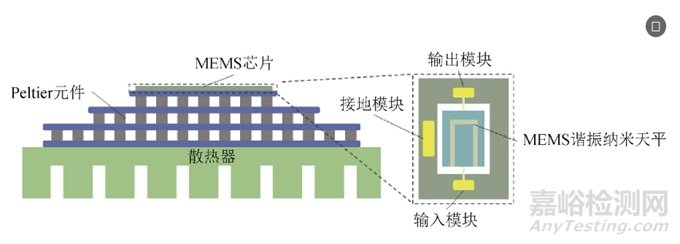
图7 压电MEMS露点温度传感器结构图
Fig.7 Structural diagram of piezoelectric MEMS dew point temperature sensor
Mahdavi M等人[63]设计了基于薄膜压电硅(Thin⁃film Piezoelectric⁃on⁃Silicon, TPoS)谐振器的新型露点计,将微机电谐振天平与冷却元件相结合,当露水或霜开始形成时,谐振频率达到最大值。该课题组进行了35 000次不间断测量,研究了传感器的长期可靠性和准确性。Wang T等人[64]制作了基于MEMS压电圆谐振腔和悬臂梁的露点传感器,并提出了考虑相对湿度对谐振频率影响的分段函数拟合露点识别方法,该方法的露点检测误差较小。实验结果表明:压电谐振露点传感器具有良好的精度和稳定性,露点的最大相对误差不超过± 0.3 ℃。
压电MEMS露点温度传感器的一般测量范围为-41 ~ 4 ℃,测量误差不超过± 0.3 ℃,通常应用于工业制造等领域中的露点温度测量,具有体积小、功耗低、灵敏度高、器件温频效应呈线性规律的优点,但是抗干扰能力较低,且后端电路复杂。
1.2.4 谐振腔露点温度传感器
谐振腔露点温度传感器的工作原理为:潮湿的空气从湿度发生器流过谐振腔,通过测量所选微波模式的频率比计算得出露点温度。
May E F等人[65-66]开发并测试了一种可重入谐振器,用于澳大利亚西北大陆架天然气流体中的自动相界测量,实验表明该谐振器能够检测二元混合物中的相边界。Underwood R J等人[67]报导了基于准球形微波谐振器的露点湿度计的首次测量,验证了该设备在露点9.5 ~ 13.5 ℃的使用性能。
谐振腔露点温度传感器的一般测量范围为5 ~ 20 ℃,测量误差不超过± 0.1 ℃,通常用于测量有机混合气的露点温度。谐振腔露点温度传感器分辨力高、响应快、适应性强,常用来测量混合有机气体,但是设计繁琐,结构复杂(特别是核心部件)。
1.2.5 光子谐振露点温度传感器
Tao J等人[68]展示了一种紧凑的集成光子露点传感器(Dew Point Zensor, DPS),其具有高精度、占地面积小、响应速度快的特点。该DPS的核心是一个部分暴露的光子微环谐振器,它同时具有两个功能:①通过倏逝场感应冷凝水滴;②基于热光效应作为高精度的原位温度传感器。该装置大大降低了影响传统冷镜湿度计测量效果的大部分与温度相关的误差。此外,该DPS的尺寸、成本、响应时间均优于传统的冷镜式湿度计,应用范围更广,为实现芯片上露点检测铺平了道路。
光子谐振露点温度传感器的一般测量范围为-41 ~ 4 ℃,测量误差不超过± 0.3 ℃,通常应用于皮肤含水量、呼吸检测等领域的露点温度测量。光子谐振露点温度传感器体积较小,温度灵敏度较高,但对光学器件要求很高。
谐振式露点温度传感器指标如表2所示。
表2 谐振式露点温度传感器指标单位:℃
Tab.2 Index of resonant dew point temperature sensor
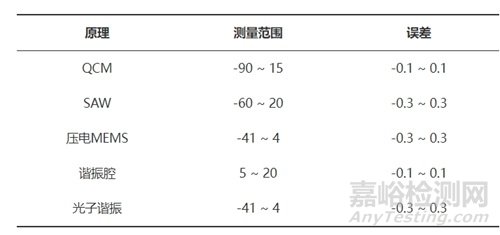
1.3 电学式露点温度传感器
电学式露点温度传感器利用露点产生时引起的电参数变化进行传感检测。电学式露点温度传感器可分为电容式、电阻式、β伏特效应式等。
1.3.1 电容式露点温度传感器
电容式露点温度传感器(如图8所示)利用光刻技术在硅基材料上制备交叉式并联极板电容器,通过测量水分凝结导致的电容变化实现露点检测。
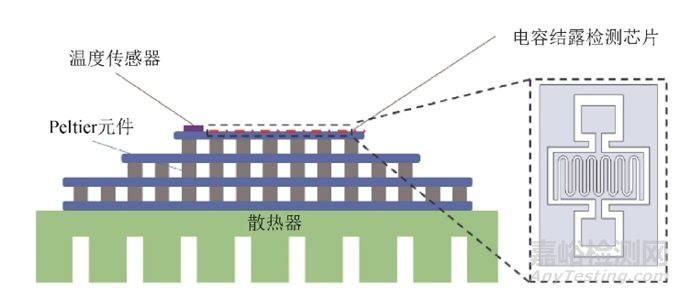
图8 电容式露点温度传感器结构图
Fig.8 Structural diagram of capacitive dew point temperature sensor
Chen Z等人[69]采用反应蒸发Al2O3薄膜作为多孔介质,研制了基于Au多孔Al2O3⁃Ni结构的湿度传感器。Krutovertsev S A等人[70]研制了一种集成式多功能湿度传感器,可在不同条件下进行宽湿度范围测量。Baglio S等人[71-72]设计了一种采用标准互补金属氧化物半导体(Complementary Metal⁃Oxide⁃Semiconductor, CMOS)技术的露点相对湿度微传感器,其利用热电效应实现悬浮板冷却和露点和环境温度测量,通过电容感测实现露点检测。仿真结果表明,该器件可以在标准大气压和环境温度10 ~ 30 ℃条件下测量40% ~ 95%范围内的相对湿度,响应时间小于10 ms,总功耗为196 mW。Vorobets G I等人[73]提出了一种无损测量集成电路和半导体器件中密封玻璃金属或陶瓷金属封装中水分含量的方法,温度测量周期的相对误差不超过5%,持续时间小于25 min。Jachowicz R等人[74-92]研制了新型硅露点探测器,该探测器由1个温度计、2个加热器、1个用于检测水、过冷水以及冰的电容式交叉数字传感器组成。该课题组详细介绍了过冷水识别的试验结果,讨论了电容式交叉式传感器的理论模型,描述了该传感器的检测原理,并利用该原理成功开发了一种新型指纹传感器。该课题组还介绍了一种应用于喉科的新型快速半导体露点湿度计,它可以测量吸入空气的温度和露点温度的动态变化,提供了一种利用快速露点湿度计传感器测量人体皮肤含水量的新思路。该湿度计每秒可进行5至6次测量,不确定度小于0.3 K,露点测量范围为-10 ~ 40 ℃。此外,该课题组报道了全新的、首次制成的印刷式露点传感器,该传感器完全采用喷墨打印技术制造,同时包含加热模块和热敏电阻模块。Khan A U等人[93]开发了基于信号调理电路的电容式露点温度传感器,在4 × 10-6 ~ 1 × 10-4的满量程湿度范围内,与露点仪(误差不超过± 0.1%)相比,该传感器的湿度测量误差不超过± 1%,分辨力为10-6。Schönberg J N等人[94]研究了不同表面改性传感器在不同环境条件下的湿度和露点测量性能,分析了水吸附和表面润湿行为影响传感器性能的模型。Stehle J等人[95-96]研制了一种纯硅电容式露点传感器,露点温度测量误差不超过± 2 ℃,响应时间小于40 s,并且性能有望进一步提高。Siddiqui A等人[97]讨论了一种低成本无源无线的电容式传感器,将该传感器性能与商用露点仪进行了比较,结果显示在6.5 × 10-6 ~ 12.7 × 10-6的湿度范围内误差不超过± 1%。Kumar S等人[98]提出了一种用于跟踪水分传感的老化电容传感器的数学模型,并进行了等效电路和长期漂移分析。采用多孔氧化铝薄膜制备传感器检测3 × 10-6 ~ 1 × 10-4的水分。Dario C[99]提出了一种将温度传感器与相对湿度传感器相结合,并对结合后系统进行预热的方法,使该系统达到RH传感器的最佳性能区间,并在较高温度和较低相对湿度条件下进行测量。聂晶等人[100]使用多孔石墨烯数字间电极构建电容传感器,结果表明碳基露点传感器测量误差不超过± 0.8 ℃,优于其他基于电感测参数的露点仪,具有良好的稳定性和重复性。Islam T等人[101]提出了一种基于传感器的低成本变压器油水分在线测量方案,采用低成本材料制备了一种薄膜平行板电容式水分传感器,用于测量新鲜、陈化和含水0.5%油样的水分。韩国标准科学研究院[102]开发了一款高空模拟器,其工作温度范围为-70 ~ 20 ℃,露点/霜点温度范围为-80 ~ 20 ℃,相对湿度范围为5% ~ 100%。Burgass R等人[103]提出了一种测量气体中露点 / 霜点的新方法,并建立了实验装置对氮气、甲烷和天然气进行测量,结果显示测量误差不超过± 0.1 ℃。
电容式露点温度传感器的一般测量范围为-20 ~ 20 ℃,测量误差不超过± 0.1 ℃,多结合感湿材料应用于工业领域环境露点温度测量。电容式露点温度传感器体积小、制作简易、功耗低,便于实现小型化、集成化。
1.3.2 电阻式露点温度传感器
电阻式露点温度传感器的半导体制冷器陶瓷冷面安装有热敏电阻、加热器和叉指电极,当电极表面产生凝结时,根据电极的导纳变化识别露点,并利用热敏电阻测得露点温度,结构如图9所示。
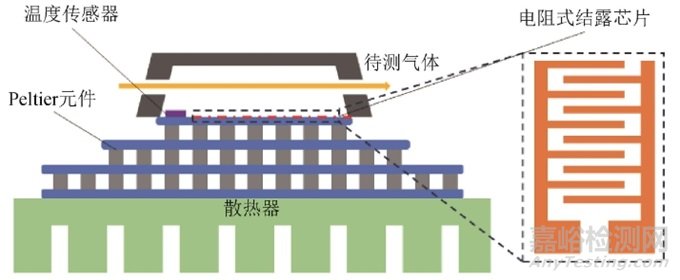
图9 电阻式露点温度传感器结构图
Fig.9 Structural diagram of resistance type dew point temperature sensor
Graichen H等人[104]基于露点温度时冷却表面上的水沉积原理开发了一种露点湿度计,可安装在用于测量皮肤表面水蒸气损失的常规通风汗囊内。Seginer I等人[105]报道了一种冷却式湿度传感器及其在温室夜间湿度控制中的应用。Montross M D等人[106]利用市售的叶片湿度传感器,设计了一个冷凝传感和控制系统来检测冷凝,其具有低成本、坚固耐用、日常维护方便等优点。Scardaci V等人[107]展示了三种基于柔性基板上喷涂沉积碳纳米管网络的传感器,薄片电阻的阻值随着薄膜温度的变化而改变,基于此原理检测露点温度。Wu Y等人[108]设计了一种适用于密封舱室的水分测量装置,实验结果表明该装置能保证在密封腔露点温度低于0 ℃下进行测量。Linke M等人[109-110]测量了大体积水果曲面上的凝结,虽然成功地测量了凝结水在水果表面的停留时间,但对于凝结的强度只能做出定性的陈述。
电阻式露点温度传感器主要测量范围为-20 ~ 20 ℃,测量误差不超过± 2 ℃,通常应用于呼吸检测、生物医药等领域的露点温度测量。电阻式露点温度传感器具有较高的灵敏度,且成本较低,但是由于温度对电阻影响较大,只能在一定温度范围内工作,且线性度和互换性较差,应用范围受限。
1.3.3 β伏特效应露点温度传感器
β伏特效应露点测量装置由放射性β粒子源和硅基p⁃n结组成。当p⁃n结表面干燥时,β粒子进入p⁃n结并产生稳定的直流电压,一旦形成冷凝水层,β粒子就会被阻挡,p⁃n结产生的电压会下降,通过测量电压值变化检测结露。Ezzat G.Bakhoum等人[125]利用β伏特原理对露点温度进行了测量,开发的传感器具有精度较高、体积较小的优点,在工业领域应用广泛。
β伏特效应露点温度传感器的一般测量范围为-40 ~ 40 ℃,测量误差不超过± 0.2 ℃,常用于测量特定工业环境的露点温度。β伏特效应露点温度传感器具有体积小、精度高的优势,但其使用的放射性β粒子对人体有害。
电学式露点温度传感器指标如表3所示。
表3 电学式露点温度传感器指标单位:℃
Tab.3 Index of electrical dew point temperature sensor
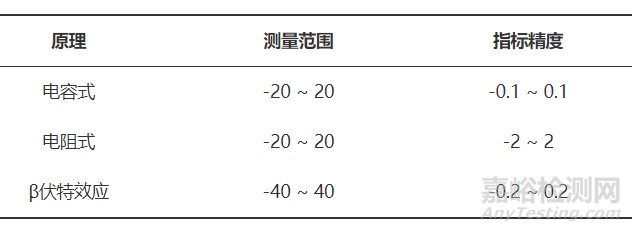
1.4 热学式露点温度传感器
热学式露点温度传感器利用露点产生时引起的热学参数变化进行传感检测。热学式露点温度传感器可分为热电式、干湿球式等。
1.4.1 热电式露点温度传感器
热电式露点温度传感器的工作原理为:当待测气流通过耦合芯片时,耦合芯片中2个单元之间的温度将发生不同改变,测量被测空气在通过芯片时所产生的温差,推导出被测空气的湿度。热电式露点温度传感器结构如图10所示。
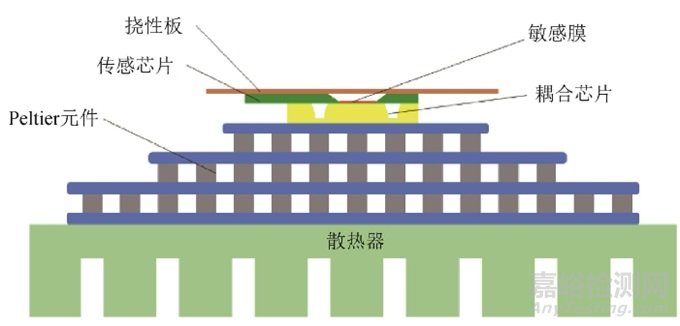
图10 热电式露点温度传感器结构图
Fig.10 Structural diagram of thermoelectric dew point temperature sensor
Jensen O M等人[113]报道了一种测量材料样品平衡相对湿度和平衡露点温度的新方法。Ancey P等人[114]设计了应用于冷凝水预防检测的新型传感器。Lang W等人[115]报道了一种特别适用于高湿度条件下的湿度测量方法。Kunze M等人[116-117]报道了一种基于热学原理检测气体中水蒸气露点温度的新方法,露点温度可低于环境温度45 ℃,最大误差不超过± 0.2 ℃。此外,Yan J等人[118]研制了基于湿敏薄膜覆盖的露点温度传感器,此传感器根据高温流场的热效应引起的温度⁃时间曲线突变检测露点。
热电式露点温度传感器的一般测量范围为5 ~ 20 ℃,测量误差不超过± 0.2 ℃,通常用于测量工业环境的露点温度。热学式露点温度传感器的测量精度一般,响应时间较长,故应用受限。
1.4.2 干湿球露点温度传感器
干湿球露点温度传感器利用干球与湿球间的温差实现露点温度测量,当空气湿度较高时,湿球上的水分蒸发较慢,湿球温度较高,干球和湿球之间的温差较小;当空气湿度较低时,湿球上的水分蒸发较快,湿球温度较低,干球和湿球之间的温差较大。根据温差与湿度之间的关系,间接得出露点温度。
Ueda M等人[119]研制了一种简单的热电干湿计,用于测量小容器中样品的平衡湿度。Gates R S等人[120]进行了分量误差分析,得出干球温度和相对湿度的测量精度与计算露点温度误差的关系。分析结果表明露点温度误差在相对湿度小于50%时最大,并随干球温度成比例增加。
干湿球露点温度传感器的一般测量范围为-40 ~ 40 ℃,测量误差不超过± 1.5 ℃,通常用于测量工业环境的露点温度。干湿球露点温度传感器成本低、结构简单、维修方便,但是对使用条件要求较高,需要良好的通风环境。
热学式露点温度传感器指标如表4所示。
表4 热学式露点温度传感器指标单位:℃
Tab.4 Index of thermal dew point temperature sensor

1.5 重量式露点温度传感器
重量式露点温度传感器的工作原理:待测气流流经干燥剂,气流中的水分被干燥剂吸收,精确称取干燥剂吸收的水分质量,之后通过计算推导可以间接得出露点温度。重量式露点温度传感器结构如图11所示。
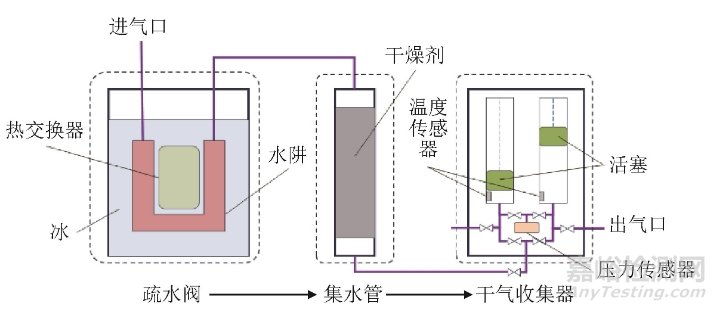
图11 重量式露点温度传感器结构图
Fig.11 Structural diagram of weight type dew point temperature sensor
Meyer C W等人[121-122]建立了一种测量压缩气体中饱和水含量的装置。饱和器通过使流动的气体与液态水保持平衡而使其加湿。然后利用重量湿度计测量潮湿气体的水摩尔分数,推导出露点温度。
重量式露点温度传感器的一般测量范围为-70 ~ 80 ℃,测量误差不超过± 0.1 ℃,可作为湿度计量的基准,精度极高,但测量过程相对繁琐,响应极慢,且需要精密保养,不适用于现场测试。
1.6 化学式露点温度传感器
化学式露点温度传感器的工作原理:待测气体与器件上的特定物质产生反应,利用原料消耗量或新生成产物量计算所消耗的水分量,间接得出露点温度。化学式露点温度传感器可分为库仑式、色谱⁃质谱式等。
1.6.1 库仑式露点温度传感器
库伦式露点温度传感器基于电化学方法,待测气体中的水在电解池中发生氧化还原反应,直至水分全部耗尽。依据法拉第电解定律,电解产物质量与电解耗电量成正比,也与被测水分的质量成正比,通过对耗电量的测量可以间接计算得出露点温度。结构如图12所示。
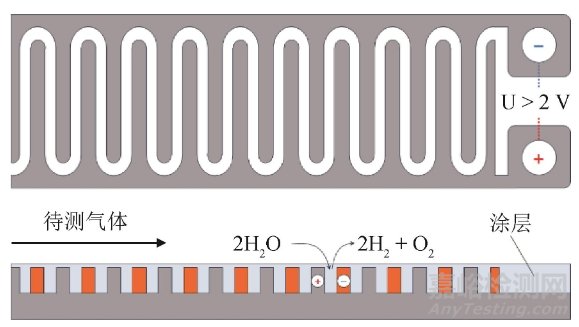
图12 库仑式露点温度传感器结构图
Fig.12 Structural diagram of Coulomb dew point temperature sensor
Detjens M等人[111-112]利用微型平面库仑传感器,在氢气、氮气、氦气、氧化亚氮和合成空气等气体中测量微量湿度。库仑式露点温度传感器主要测量范围为-90 ~ -15 ℃,测量误差不超过± 2 ℃,通常用于测量工业混合气体的露点温度。库仑式露点温度传感器结构简单、成本较低,适用于低湿度环境以及含有腐蚀性气体环境中的露点温度测量,缺点是精度较低。
1.6.2 色谱⁃质谱式露点温度传感器
色谱⁃质谱式露点温度传感器的工作原理:待测气体中的水分与特定化学物质反应后,利用分析仪将样品组分数据转变为相应的电信号,从而间接计算得到露点温度。Løkken T V等人[124]利用色谱原理进行露点温度测量,该方法测量有机混合气体的露点精度较高。色谱⁃质谱式露点温度传感器的一般测量范围为-70 ~ 10 ℃,测量误差不超过± 2 ℃,通常用于测量工业混合有机气体的露点温度。色谱⁃质谱式露点温度传感器稳定性高、耐用性好,适用于测量有机混合气体与低湿度气体的露点温度,但是对待测气体特定反应的化学物质要求严格,且精度较低。
化学式露点温度传感器指标如表5所示。
表5 化学式露点温度传感器指标单位:℃
Tab.5 Index of chemical dew point temperature sensor

2、 露点温度传感器的应用
露点温度传感器已被应用于气象监测、工业制造、农业生产、医疗诊断等领域中。Pirrotta S等人[126]利用光学式露点温度传感器进行大气与海洋结构监测,为气象研究提供了可靠的参考。早期露点温度传感器在有机混合物气体检测领域应用较为广泛,Trampe D B等人[4]、Brown A S等人[8]、Ishida K等人[27]分别采用冷镜式、图像式、QCM露点温度传感器对有机混合物气体的露点温度进行测量。露点温度是风洞试验中的重要参数,聂伟等人[15-16]、Nowak J L等人[19]利用光谱式露点温度传感器实现了风洞试验中露点温度宽范围、快响应、高稳定性测量。Hadjiloucas S等人[127]利用光学式露点温度传感器辅助农业生产,通过监测农作物生长环境湿度,使种植者能够快速制定灌溉策略。Brengelmann G L等人[1]利用光学式露点温度传感器进行汗液检测,辅助医生监测病人代谢情况。Jachowicz R等人[84]、Esmaeilzadeh H等人[55]分别利用QCM式与电学式露点温度传感器进行特定生物气体的检测,助力医药/病理成分分析。
随着科技的不断发展,前沿领域对露点温度测量提出了更高要求。高温气冷堆监测领域中,需要在200 ℃、0.1 ~ 7 MPa的环境下,对30 ~ 90 ℃的露点温度进行测量;油气田有机混合物检测领域中,需要在20 ~ 80 ℃、0.1 ~ 6 MPa的环境下,对30 ~ 40 ℃的露点温度进行测量;燃料电池研制领域中,需要在在-40 ~ 150 ℃、0.1 ~ 0.4 MPa的环境下,对40 ~ 95 ℃的露点温度进行测量。上述领域对露点温度测量范围及环境条件提出了新的要求,露点温度传感器需要在高温高压环境中,对高露点温度进行测量,并满足测量精度的要求。目前大部分传统露点温度传感器很难直接在上述极端环境下实现测量,通常需要将高温高压的待测气体转换为常温常压气体后再进行测量,虽能在一定程度上解决露点温度测量问题,但转换过程会不可避免地对待测气体造成影响,降低测量结果的准确性;且需要使用复杂的转换装置,成本较高。
3、 总结与展望
介绍了光学式、谐振式、电学式、热学式、重量式、化学式露点温度传感器的结构组成和工作原理,总结了各类露点温度传感器的优缺点,论述了露点温度传感器在环境监测、工业制造、生物医学等领域中的应用现状。随着研究的不断深入,露点温度传感器在小型化、集成化、智能化方面取得了很大进展。然而,新的机遇与诸多挑战并存,要在实践中得到广泛应用,还有很长的路要走。下面对露点温度传感器未来的发展方向进行展望:
1) 在实现高精度测量的同时实现小型化。目前高精度露点温度传感器(例如MBW373型等)通常体积庞大,较为笨重,无法实现便携化,不适用于现场环境测量;目前市场上流行的便携式露点温度传感器(例如Vaisala DMT340型等)虽能应用于现场环境测量,但测量精度远低于实验室中标准仪器的测量精度。未来需要研制准确性高且体积较小、便携性较好的露点温度传感器,以满足现场环境中高精度测量的需求。
2) 实现极端环境下的高精度、高稳定性、高响应。目前,大部分传统露点温度传感器的使用条件与测量指标很难满足极端环境下露点温度测量的要求,未来需要基于新材料研制能够在极端环境下可靠工作的露点温度传感器,实现极端工况下的高精度露点测量。
参考文献
BRENGELMANN G L, MCKEAG M, ROWELL L B. Use of dew⁃point detection for quantitative measurement of sweating rate[J]. Journal of applied physiology, 1975, 39(3): 498-500.
JACHOWICZ R S. Dew point hygrometer with heat injection — principle of construction and operation[J]. Sensors and Actuators B: Chemical, 1992, 7(1-3): 455-459.
JACHOWICZ R S, MAKULSKI W J. Optimal measurement procedures for a dew point hygrometer system[J]. IEEE Transactions on Instrumentation and Measurement, 1993, 42(4): 828-833.
TRAMPE D B, ECKERT C A. A dew point technique for limiting activity coefficients in nonionic solutions[J]. AICHE journal, 1993, 39(6): 1045-1050.
ARIAGNO R L, GLOTZBACH S F, BALDWIN R B, et al. Dew⁃point hygrometry system for measurement of evaporative water loss in infants[J]. Journal of Applied Physiology, 1997, 82(3): 1008-1017.
HUDOKLIN D, BARUKČIĆ E, DRNOVŠEK J. Engaging frost formation in a chilled⁃mirror hygrometer[J]. International Journal of Thermophysics, 2008, 29: 1598-1605.
HUDOKLIN D, ŠETINA J, DRNOVŠEK J. Uncertainty evaluation of the new setup for measurement of water⁃vapor permeation rate by a dew⁃point sensor[J]. International Journal of Thermophysics, 2012, 33: 1595-1605.
BROWN A S, MILTON M J T, VARGHA G M, et al. Measurement of the hydrocarbon dew point of real and synthetic natural gas mixtures by direct and indirect methods[J]. Energy & Fuels, 2009, 23(3): 1640-1650.
BAE Y K, HYUN D H. Effect of purging rate on the calibration of dew point sensor and the estimation of measurement uncertainty[J]. Applied Mechanics and Materials, 2014, 627: 161-167.
KOZLOV M G, KUSTIKOVA M A, TOMSKII K A. Optical hygrometer[J]. Measurement Techniques, 2005, 48(7): 731-735.
BEREZIN A G, NADEZHDINSKII A I, PONUROVSKII Y Y, et al. Detection of moisture content in high⁃purity ammonia by means of diode⁃laser spectroscopy[J]. Applied Physics B, 2008, 90: 317-321.
CERNI T A. An infrared hygrometer for atmospheric research and routine monitoring[J]. Journal of Atmospheric and Oceanic Technology, 1994, 11(2): 445-462.
KOGLBAUER G, WENDLAND M. Water vapor concentration enhancement in compressed humid nitrogen, argon, and carbon dioxide measured by Fourier transform infrared spectroscopy[J]. Journal of Chemical & Engineering Data, 2008, 53(1): 77-82.
UNDERWOOD R, GARDINER T, FINLAYSON A, et al.An improved non⁃contact thermometer and hygrometer with rapid response[J]. Metrologia, 2017, 54(1): 9-15.
NIE W, XU Z, KAN R, et al. Development of a dew / frost point temperature sensor based on tunable diode laser absorption spectroscopy and its application in a cryogenic wind tunnel[J]. Sensors, 2018, 18(8).
NIE W, LIN X, RAO G, et al. Development and validation of a laser⁃absorption⁃based method for in⁃situ and high⁃precision water vapor dew point temperature measurement[J]. Infrared Physics & Technology, 2022, 123.
KHELIFA N. Effect of measurement of dew point temperature in moist air on the absorption line at 1 392.53 nm of water vapor[J]. International Journal of Optics, 2019.
LI Q, WANG X, YANG H, et al. Research on water vapor release and adsorption mechanism to improve the measurement of dew point humidity sensor[J]. IEEE Sensors Journal, 2021, 21(13): 14666-14676.
NOWAK J L, GROSZ R, FREY W, et al. Contactless optical hygrometry in LACIS⁃T[J]. Atmospheric Measurement Techniques Discussions, 2022, 15(13): 4075-4089.
MATSUMOTO S. Development of measurement simulation of the laser dew⁃point hygrometer using an optical fiber cable[C]// Advanced Sensor Systems and Applications II. SPIE, 2005, 5634: 111-122.
MATSUMOTO S. A new type of dynamic optical dew⁃point sensor using a laser diode and an optical fiber cable[C]// Sensors. IEEE, 2005.
MATHEW J, SEMENOVA Y, FARRELL G. Photonic crystal fiber interferometer for dew detection[J]. Journal of Lightwave Technology, 2011, 30(8): 1150-1155.
KOSTRITSKII S M, DIKEVICH A A, KORKISHKO Y N, et al. Dew point measurement technique utilizing fiber cut reflection[C]// Optical Sensors 2009. SPIE, 2009, 7356: 380-387.
CHEN G Y, WU X, KANG Y Q, et al. Ultra⁃fast hygrometer based on U⁃shaped optical microfiber with nanoporous polyelectrolyte coating[J]. Scientific Reports, 2017, 7(1).
LIMODEHI H E, MOZAFARI M, AMIRI H, et al. Multi⁃channel fiber optic dew and humidity sensor[J]. Optical Fiber Technology, 2018, 41: 89-94.
WEREMCZUK J, WAWRZYNIAK Z, JACHOWICZ R S. A new method of super⁃cooled water recognition in dew point hygrometer by morphology⁃based image processing[J]. Sensors and Actuators A: Physical, 2004, 111(2-3): 240-244.
ISHIDA K, KOSAKA M, MONDE M. Dew and frost points measurements and estimation for residual gases in high⁃pressure hydrogen[C]// ASME / JSME Thermal Engineering Joint Conference. 2011.
SHAPIRO A P, DEAN A J. Quartz crystal microbalance dewpoint sensor for natural gas[J]. Internal Standardization and Calibration Architectures for Chemical Sensors, 1999, 3856: 148-159.
JOUNG O J, KIM Y H. Dew point measurement for organic vapor mixture using a quartz crystal sensor[J]. Sensors and Actuators B: Chemical, 2006, 113: 335-340.
KWON S Y, KIM J C, CHOI B I. Recognition of supercooled dew in a quartz crystal microbalance dew⁃point sensor by slip phenomena[J]. Metrologia, 2007, 44(5): 37-43.
KWON S Y, KIM J C, CHOI B I. Accurate dew⁃point measurement over a wide temperature range using a quartz crystal microbalance dew⁃point sensor[J]. Measurement Science and Technology, 2008, 19(11).
NIE J, MENG X F, WANG S, et al. Dew point measurement using a sensitive circuit type of dew point sensor[J]. Appl. Math Inf. Sci., 2012, 6(3): 863-868.
WANG S, MENG X, WANG G, et al. Study on wet sensitive characteristics of Colpitts oscillation circuit[C]// 2nd International Conference on Electronic & Mechanical Engineering and Information Technology. Atlantis Press, 2012: 1927-1931.
NIE J, MENG X F, XU L J, et al. Dew point measurement using a quartz crystal sensor[C]// 2013 IEEE International Instrumentation and Measurement Technology Conference (I2MTC). IEEE, 2013: 41-44.
WANG G, ZHANG W, WANG S, et al. A quartz crystal microbalance dew point sensor without frequency measurement[J]. Review of Scientific Instruments, 2014, 85(11).
NIE J, MENG X. Dew point and relative humidity measurement using a quartz resonant sensor[J]. Microsystem Technologies, 2014, 20: 1311-1315.
NIE J, MENG X. Microscopic verification of sensitive circuits of a quartz resonator applied in dew point recognition[J]. Microsystem Technologies, 2015, 21: 641-647.
YANG Y, MENG X, WANG Q. Optimization of dew point sensitive structure based on a quartz resonant sensor[C]// 4th International Conference on Information Technology and Management Innovation. Atlantis Press, 2015: 1211-1216.
NIE J, LIU J, MENG X. A new type of fast dew point sensor using quartz crystal without frequency measurement[J]. Sensors and Actuators B: Chemical, 2016, 236: 749-758.
LIN N, MENG X, NIE J. Dew point calibration system using a quartz crystal sensor with a differential frequency method[J]. Sensors, 2016, 16(11).
LI N, MENG X, NIE J. Note: a dual⁃channel sensor for dew point measurement based on quartz crystal microbalance[J]. Review of Scientific Instruments, 2017, 88(5).
NIE J, LIU J, MENG X. Dew point fast measurement in organic vapor mixtures using quartz resonant sensor[J]. Review of Scientific Instruments, 2017, 88(1).
NIE J, LIU J, LI N, et al. Dew point measurement using dual quartz crystal resonator sensor[J]. Sensors and Actuators B: Chemical, 2017, 246: 792-799.
LIN N, NIE J, MENG X. Research on the frequency stability of a bonded QCM for dew point measurement[J]. Microsystem Technologies, 2017, 23: 3653-3659.
LI N, MENG X, NIE J, et al. A QCM dew point sensor with active temperature control using thermally conductive electrodes[J]. IEEE Sensors Journal, 2018, 18(14): 5715-5722.
NIE J, MENG X, LI N, et al. Active temperature control of quartz resonant dew point sensors based on dual surface cooling[J]. Sensors and Actuators B: Chemical, 2018, 256: 1-6.
TIAN J, MENG X, NIE J, et al. High accuracy frequency extraction based on sigma⁃delta ADC applied in resonant dew point sensor[J]. Measurement, 2018, 119: 77-84.
LIU J, NIE J, MENG X. Note: Temperature⁃frequency calibration method based on spectral analysis for QCR dew point sensor[J]. Review of Scientific Instruments, 2018, 89(6).
NIE J, MENG X, LI N. Quartz crystal sensor using direct digital synthesis for dew point measurement[J]. Measurement, 2018, 117: 73-79.
LI N, MENG X, NIE J, et al. Structure optimization and performance evaluation of dew point sensors based on quartz crystal microbalance[J]. IEEE Sensors Journal, 2017, 18(3): 1016-1022.
LI N, HUANG Q, NIE J, et al. Dew point measurements using montmorillonite (MTT) and molybdenum disulfide (MoS2) coated QCM sensors[J]. Sensors and Actuators B: Chemical, 2019, 279: 122-129.
NIE J, HUANG Q, LI N, et al. Swelling characteristics and application of two⁃dimensional materials on hydrophilic quartz crystal resonant dew point sensor[J]. Sensors and Actuators B: Chemical, 2019, 298.
NIE J, MENG X, LIN L. High⁃accuracy quartz crystal resonance DP instrument[J]. IEEE Transactions on Industrial Electronics, 2019, 67(9): 8026-8033.
LI N, WANG G, BAI X, et al. Effect of quartz crystal thermal stress on its performance in active temperature control quartz crystal microbalance dew point sensors[J]. Sensors and Actuators B: Chemical, 2022, 369.
ESMAEILZADEH H, SU J, JI S, et al. An ultrasensitive acoustic wave resonator device enabled by gluing a replaceable micropillar film[J]. Microsystem Technologies, 2019, 25: 4151-4161.
VETELINO K, STORY P R, GALIPEAU D W.A comparison of SAW and optical dew point measurement techniques[C]// Ultrasonics Symposium, 1995. Proceedings. IEEE, 1995.
GALIPEAU D W, STROSCHINE J D, Snow K A, et al. A study of condensation and dew point using a SAW sensor[J]. Sensors and Actuators B: Chemical, 1995, 25(1-3): 696-700.
ETELINO K A, STORY P R, MILEHAM R D, et al. Improved dew point measurements based on a SAW sensor[J]. Sensors and Actuators B: Chemical, 1996, 35(1-3): 91-98.
GALIPEAU D W, STORY P R, VETELINO K A, et al. Surface acoustic wave microsensors and applications[J]. Smart Materials and Structures, 1997, 6(6).
HOUMMADY M, BONJOUR C, COLLIN J, et al. Surface acoustic wave (SAW) dew point
HANSFORD G M, FRESHWATER R A, EDEN L, et al. Lightweight dew⁃ / frost⁃point hygrometer based on a surface⁃acoustic⁃wave sensor for balloon⁃borne atmospheric water vapor profile sounding[J]. Review of Scientific Instruments, 2006, 77(1).
TAKEDA N, CARROLL P, TSUKAHARA Y, et al. Trace moisture measurement in natural gas mixtures with a single calibration for nitrogen background gas[J]. Measurement Science and Technology, 2020, 31(10).
MAHDAVI M, MEHDIZADEH E, POURKAMALI S. Piezoelectric MEMS resonant dew point meters[J]. Sensors and Actuators A: Physical, 2018, 276: 52-61.
WANG T, GUAN Y, PANG J, et al. An accurate dew point sensor based on MEMS piezoelectric resonator and piecewise fitting method[J]. Sensors and Actuators B: Chemical, 2022, 370.
MAY E F, EDWARDS T J, MANN A G, et al. Development of an automated phase behaviour measurement system for lean hydrocarbon fluid mixtures, using re⁃entrant rf / microwave resonant cavities[J]. Fluid Phase Equilibria, 2001, 185(1-2): 339-347.
MAY E F, EDWARDS T J, MANN A G, et al. Dew point, liquid volume, and dielectric constant measurements in a vapor mixture of methane + propane using a microwave apparatus[J]. International Journal of Thermophysics, 2003, 24: 1509-1525.
UNDERWOOD R J, CUCCARO R, BELL S, et al. A microwave resonance dew⁃point hygrometer[J]. Measurement Science and Technology, 2012, 23(8).
TAO J, LUO Y, WANG L, et al. An ultrahigh⁃accuracy miniature dew point sensor based on an integrated photonics platform[J]. Scientific reports, 2016, 6(1).
CHEN Z, JIN M C, ZHEN C. Humidity sensors with reactively evaporated Al2O3 films as porous dielectrics[J]. Sensors and Actuators B: Chemical, 1990, 2(3): 167-171.
KRUTOVERTSEV S A, TARASOVA A E, KRUTOVER TSEVA L S, et al. Integrated multifunctional humidity sensor[J]. Sensors and Actuators A: Physical, 1997, 62(1-3): 582-585.
BAGLIO S, CASTORINA S, SACCO V, et al. Dew⁃point relative humidity CMOS microsensors[C]// Sensors. IEEE, 2004: 103-106.
SAVALLI N, BAGLIO S, CASTORINA S, et al. Integrated CMOS dew point sensors for relative humidity measurement[C]// Smart Structures and Materials 2004: Smart Electronics, MEMS, BioMEMS, and Nanotechnology. SPIE, 2004, 5389: 422-430.
VOROBETS G I, ZHUK O P, ILARIONOV O E, et al. Measurement of air humidity inside electronic devices[J]. Instruments and Experimental Techniques, 2001, 44(2): 266-268.
JACHOWICZ R, WEREMCZUK J. Sub⁃cooled water detection in silicon dew point hygrometer[J]. Sensors and Actuators A: Physical, 2000, 85(1-3): 75-83.
WEREMCZUK J, GNIAZDOWSKI Z, ŁYSKO J M, et al. Optimization of semiconductor dew point hygrometer mirrors surface temperature homogeneity[J]. Sensors and Actuators A: Physical, 2001, 92(1-3): 10-15.
WEREMCZUK J. Silicon dew point hygrometer model[C]// IMTC 2001. Proceedings of the 18th IEEE Instrumentation and Measurement Technology Conference. Rediscovering Measurement in the Age of Informatics (Cat. No. 01CH 37188). IEEE, 2001, 3: 1823-1837.
WEREMCZUK J, GNIAZDOWSKI Z, JACHOWICZ R, et al. Temperature distribution model for the semiconductor dew point detector[C]// Optoelectronic and Electronic Sensors IV. SPIE, 2001, 4516: 174-180.
WEREMCZUK J. Water molecules and heat transfer modeling in silicon dew point hygrometer[J]. IEEE Transactions on Instrumentation and Measurement, 2002, 51(6): 1223-1227.
JACHOWICZ R, WEREMCZUK J, PACZESNY D, et al. Fast dew⁃point hygrometer for laryngology applications[C]// Sensors. IEEE, 2004: 1488-1491.
JACHOWIEZ R, J WEREMCZUK J, PACZESNY D, et al. Sensors system and operation algorithm for humidity and temperature measurements inside human nose and human throat[C]// Sensors. IEEE, 2005.
JACHOWICZ R, WEREMCZUK J, TARAPATA G. Transepidermal water loss sensor based on fast dew point hygrometer[J]. Sensors and Actuators A: Physical, 2005, 123: 7-11.
WEREMCZUK J, TARAPATA G, PACZESNY D, et al. Fast dew point hygrometer with silicon integrated detector — optimization of dynamic properties[J]. Sensors and Actuators A: Physical, 2006, 132(1): 195-198.
PACZESNY D, TARAPATA G, WEREMCZUK J, et al. Autocalibration of dew point hygrometer based on integrated semiconductor detector[C]// Instrumentation & Measurement Technology Conference. IEEE, 2007: 1-4.
WEREMCZUK J. Dew / Frost point recognition with fingerprint sensor[C]// Instrumentation & Measurement Technology Conference. IEEE, 2007: 1-3.
MÜNDLEIN M, VALENTIN B, CHABICOVSKY R, et al. Comparison of transepidermal water loss (TEWL) measurements with two novel sensors based on different sensing principles[J]. Sensors and Actuators A: Physical, 2008, 142(1): 67-72.
WEREMCZUK J. Dew / frost point recognition with impedance matrix of fingerprint sensor[J]. IEEE Transactions on Instrumentation and Measurement, 2008, 57(8): 1791-1795.
JACHOWICZ R S, WEREMCZUK J, PACZESNY D, et al. A MEMS⁃based super fast dew point hygrometer — construction and medical applications[J]. Measurement Science and Technology, 2009, 20(12).
WEREMCZUK J, IWASZKO R, JACHOWICZ R. The method of water molecules counting during condensation process in the dew point detector[J]. Sensors and Actuators B: Chemical, 2012, 175: 137-141.
JACHOWICZ R, TARAPATA G, PACZESNY D, et al. Influence of the top dielectric layer on interdigitated capacitive dew point detector operation[J]. Procedia Engineering, 2015, 120: 1120-1123.
MARZĘCKI M, JACHOWICZ R, TARAPATA G. Multilayer inkjet printed dew point hygrometer[J]. Sensors and Actuators B: Chemical, 2018, 264: 76-83.
SELMA R, TARAPATA G, MARZĘCKI M. Comparison of absolute and relative air humidity sensors fabricated with inkjet printing technology[C]// Photonics Applications in Astronomy, Communications, Industry, and High⁃Energy Physics Experiments 2015. SPIE, 2015, 9662: 1251-1260.
TARAPATA G, MARZĘCKI M, SELMA R, et al. Novel dew point hygrometer fabricated with inkjet printing technology[J]. Sensors and Actuators A: Physical, 2016, 247: 641-646.
KHAN A U, ISLAM T, AKHTAR J. An oscillator⁃based active bridge circuit for interfacing capacitive sensors with microcontroller compatibility[J]. IEEE Transactions on Instrumentation and Measurement, 2016, 65(11): 2560-2568.
SCHÖNBERG J N, KONDRASHOV V, PROKHOROV A, et al. Capacitive humidity and dew⁃point sensing: influence of wetting of surface⁃attached polymer monolayers on the sensor response[J]. Sensors and Actuators B: Chemical, 2016, 222: 87-94.
STEHLE J, AMBACHER O, SAMARAO A, et al. Study of a silicon parallel plate capacitor as a dew point sensor[C]// Sensors. IEEE, 2016: 1-3.
STEHLE J, SAMARAO A K, YAMA G, et al. Development of a silicon⁃only capacitive dew point sensor[J]. IEEE Sensors Journal, 2017, 17(22): 7223-7230.
SIDDIQUI A, MAHBOOB R, ISLAM T. A passive wireless tag with digital readout unit for wide range humidity measurement[J]. IEEE Transactions on Instrumentation and Measurement, 2017, 66(5): 1013-1020.
KUMAR S, ISLAM T, RAINA K K. Study of long term drift of aluminum oxide thin film capacitive moisture sensor[J]. IEEE Transactions on Device and Materials Reliability, 2018, 18(2): 180-188.
DARIO C. A method to obtain precise determinations of relative humidity using thin film capacitive sensors under normal or extreme humidity conditions[J]. Journal of Cultural Heritage, 2019, 37: 166-169.
NIE J, WU Y, HUANG Q, et al. Dew point measurement using a carbon⁃based capacitive sensor with active temperature control[J]. ACS applied materials & interfaces, 2018, 11(1): 1699-1705.
ISLAM T, TEHSEEN Z, KUMAR L. Highly sensitive thin‐film capacitive sensor for online moisture measurement in transformer oil[J]. IET Science, Measurement & Technology, 2020, 14(4): 416-422.
LEE S W, KIM S, CHOI B I, et al. Calibration of RS41 humidity sensors by using an upper‐air simulator[J]. Meteorological Applications, 2021, 28(4).
BURGASS R, CHAPOY A, DE OLIVEIRA CAVALCANTI FILHO V. Development of a new method for measurement of the water dew / frost point of gas[J]. Fluid Phase Equilibria, 2021, 530.
GRAICHEN H, RASCATI R, GONZALEZ R R. Automatic dew-point temperature sensor[J]. Journal of Applied Physiology, 1982, 52(6): 1658-1660.
SEGINER I, ZLOCHIN I. Night-time greenhouse humidity control with a cooled wetness sensor[J]. Agricultural and Forest Meteorology, 1997, 85(3-4): 269-277.
MONTROSS M D, DUNCAN G A, GATES R S. Development and testing of a low⁃cost condensation detection system[J]. Applied Engineering in Agriculture, 2006, 22(4): 603-608.
SCARDACI V, COULL R, COLEMAN J N, et al. Carbon Nanotube network based sensors[C]// 2012 12th IEEE International Conference on Nanotechnology (IEEE⁃NANO). IEEE, 2012: 1-3.
WU Y, GUO Q, YUAN W, et al. Research on water vapor measurement and removal methods for the spacecraft sealed cabin[C]// IOP Conference Series: Materials Science and Engineering. IOP Publishing, 2020, 793(1).
LINKE M, PRAEGER U, MAHAJAN P V, et al. Water vapour condensation on the surface of bulky fruit: some basics and a simple measurement method[J]. Journal of Food Engineering, 2021, 307.
LINKE M, PRAEGER U, NEUWALD D A, et al. Measurement of water vapor condensation on apple surfaces during controlled atmosphere storage[J]. Sensors, 2023, 23(3).
DETJENS M, HÜBERT T, TIEBE C, et al. Coulometric trace humidity measurement in technical gases[J]. Review of Scientific Instruments, 2018, 89(8).
TIEBE C, DETJENS M, BANACH U, et al. Measurement uncertainty of coulometric trace humidity sensors[J].TM⁃Technisches Messen, 2018, 85(12): 746-753.
JENSEN O M. A method for high accuracy determination of equilibrium relative humidity[J]. Sensors and Actuators A: Physical, 2012, 181: 13-19.
ANCEY P, GSCHWIND M, VANCAUWENBERGHE O. New concept of integrated Peltier cooling device for the preventive detection of water condensation[J]. Sensors and Actuators B: Chemical, 1995, 27(1-3): 303-307.
LANG W, GLOSCH H, BILLAT S, et al. Humidity measurement by dynamic dew⁃point detection[C]// Transducers'03. 12th International Conference on Solid⁃State Sensors, Actuators and Microsystems. Digest of Technical Papers (Cat. No. 03TH8664). IEEE, 2003, 2: 1864-1866.
KUNZE M, GLOSCH H, EHRBRECHT B, et al. Thermal dewpoint sensing: a new approach for dewpoint detection and humidity sensing[C]// 2007 IEEE 20th International Conference on Micro Electro Mechanical Systems (MEMS). IEEE, 2007: 119-122.
KUNZE M, MERZ J, HUMMEL W J, et al. A micro dew point sensor with a thermal detection principle[J]. Measurement Science and Technology, 2011, 23(1).
YAN J, WANG H, ZHENG Y, et al. A novel dew point measurement system based on the thermal effect of humidity sensitive thin film[J]. Measurement, 2022, 187.
UEDA M, HARAGUCHI M, YAGI Y. A simple thermoelectric psychrometer formeasurement of equilibrium humidity[J]. Drying Technology, 1991, 9(4): 875-881.
GATES R S. Technical notes: dew point temperature error from measuring dry bulb temperature and relative humidity[J]. Transactions of the ASAE, 1994, 37(2): 687-688.
MEYER C W, HODGES J T, HYLAND R W, et al. The second⁃generation NIST standard hygrometer[J]. Metrologia, 2010, 47(3): 192-207.
MEYER C W, HARVEY A H. Dew‐point measurements for water in compressed carbon dioxide[J]. AIChE Journal, 2015, 61(9): 2913-2925.
MATSUGUCHI M, UNO T, YAMANAKA A, et al. Improvements in the long⁃term stability of a LiCl dew⁃point sensor using cross⁃linked porous poly (vinyl alcohol) film[J]. Sensors and Actuators B: Chemical, 2004, 97(1): 74-80.
LØKKEN T V. Water vapour measurements in natural gas in the presence of ethylene glycol[J]. Journal of Natural Gas Science and Engineering, 2013, 12: 13-21.
BAKHOUM E G, CHENG M H M. High⁃accuracy miniature dew point sensor and instrument[J]. IEEE Sensors Journal, 2014, 15(3): 1482-1488.
PIRROTTA S, GUGLIELMINO E. Optical psychrometer for relative humidity measurement in non⁃conventional environments[C]// Third European Workshop on Optical Fibre Sensors. SPIE, 2007, 6619: 343-346.
HADJILOUCAS S, IRVINE J, KEATING D A. Feedback dew⁃point sensor utilizing optimally cut plastic optical fibres[J]. Measurement Science and Technology, 2000, 11(1).
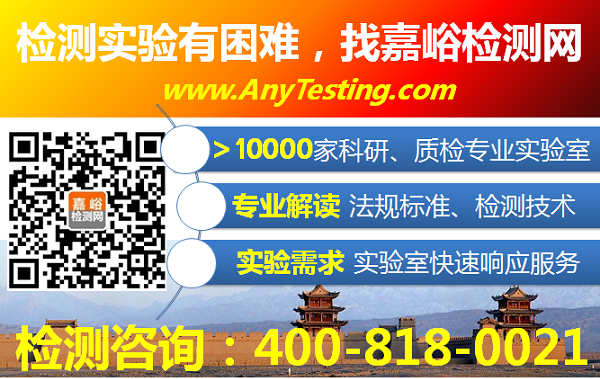
来源:Internet


